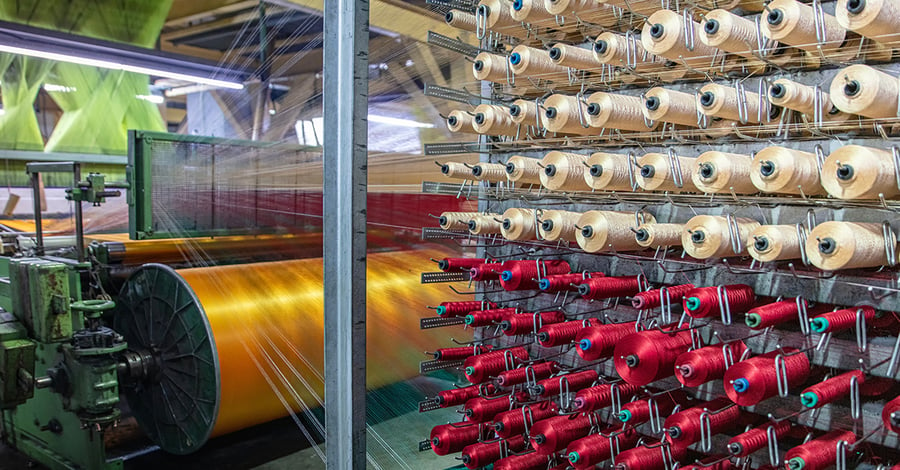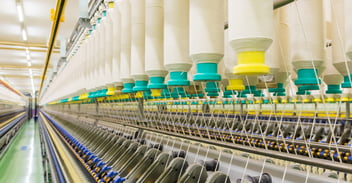

The textile industry’s complex ecosystem, from sourcing raw materials to delivering products, faces challenges maintaining visibility across global supply chains. With sustainability now a priority, the demand for traceability and compliance is growing. As the global textile market, valued at USD 1,837.27 billion in 2023, is expected to grow at a 7.4% CAGR from 2024 to 2030, textile companies must meet regulatory, ethical, and sustainability standards while meeting the growing demand.
Enterprise Resource Planning (ERP) systems can become an essential tool for textile companies in tackling these challenges. They can help centralize data and streamline operations to ensure traceability and compliance. Continue reading to find out how textile ERP transforms the industry.
Understanding Traceability and Compliance in Textiles
Traceability
Traceability in the textile industry refers to the ability to track the journey of a product from its raw materials to the finished good. This ensures product quality, safety, and compliance with regulations. Traceability allows companies to quickly identify and isolate affected items in case of a product recall. It also helps verify the authenticity of materials and meet ethical and sustainable standards. For example, a consumer can use traceability to determine if their cotton shirt was made from sustainably sourced cotton or if their leather jacket was produced ethically.
Compliance
Textile companies must adhere to a complex web of regulations and standards to ensure ethical and sustainable practices. Some key examples include:
- REACH (Registration, Evaluation, Authorization, and Restriction of Chemicals): Regulates the use of chemicals and restricts certain substances that are known or suspected to be carcinogenic, mutagenic, or reproductive toxicants.
- GOTS (Global Organic Textile Standard): Certifies organic textiles, ensuring they meet strict environmental and social criteria.
- ZDHC (Zero Discharge of Hazardous Chemicals): Promotes the elimination of harmful chemicals from the textile supply chain.
- OHS (Occupational Health and Safety) Compliance: Ensures garment manufacturing facilities follow the required standards.
- Biocidal Products Regulation: Governs the use of biocidal products in textile treatments, ensuring their safety and efficacy.
- AZO Dye Regulation: Limits certain AZO dyes in textiles, which can release aromatic amines harmful to humans.
A textile company must comply with REACH by using only approved chemicals and must obtain GOTS certification to label its products as organic.
Challenges Faced by Textile Companies in Ensuring Traceability and Compliance
- Complex Supply Chains: Textile supply chains often involve multiple tiers and suppliers, making it difficult to track the journey of materials from farm to factory. For example, a cotton shirt might pass through several countries before reaching the final consumer, making it challenging to verify the sustainability of the cotton used.
- Data Fragmentation: Information may be scattered across various systems and departments, hindering a comprehensive view of the supply chain. This can make it difficult to identify and address compliance issues promptly.
- Third-Party Involvement: Reliance on third-party suppliers and contractors can make it challenging to monitor compliance with ethical and environmental standards. For instance, a textile company may outsource dyeing processes to a third-party facility, making it difficult to ensure that hazardous chemicals are not being used.
- Changing Regulations: Adhering to evolving regulations and standards can be time-consuming and costly. For example, the EU's REACH regulation has undergone several updates, requiring textile companies to continually adapt their practices.
- Lack of Standardization: Variations in data formats and reporting requirements can create inconsistencies and make it difficult to compare information across different suppliers and regions.
- Cost and Resource Constraints: Implementing traceability and compliance measures can require significant investments in technology and personnel. Smaller textile companies may face challenges in allocating the necessary resources.
- Language and Cultural Barriers: Communicating and enforcing standards across diverse regions can be challenging. For example, a textile company operating in China may need to navigate cultural differences and language barriers when working with suppliers in Vietnam.
- Data Privacy Concerns: Protecting sensitive data while maintaining transparency can be a delicate balance. For instance, textile companies may need to collect and store personal information about workers and suppliers, raising concerns about data privacy and security.
- Lack of Transparency: A lack of transparency in the supply chain can lead to issues like counterfeit products and unethical labor practices. It can also cause supply chain disruptions and loss of trust.
- Environmental issues: The textile industry faces environmental challenges like water contamination, which can be caused by chemicals used in processing and impurities removed from fibers.
ERP Systems as a Solution for Traceability
Textile ERP can revolutionize supply chain visibility by centralizing data from various sources, including production, inventory, and quality control. This enables real-time tracking of materials, products, and processes. For example, a textile company can monitor the progress of a specific order, identify potential bottlenecks, and track the use of certified organic materials using textile ERP. This centralized data gives a comprehensive view of the supply chain, empowering companies to make informed decisions, and promptly respond to challenges.
Key ERP features for traceability
Raw Material Sourcing Tracking
- Yarn Realization (YR): Every online transaction is accurately maintained with a single-step YR calculation that includes actual yarn production, waste production, raw material usage, and in-progress stock details. Calculating YR at the end of every month typically saves an entire day. In addition, YR can be across the dimensions of mills, yarn type, mix, and product orders.
- Supplier management: Centralize information about suppliers, including certifications, contact details, and performance history using ERP systems.
- Material traceability: Track the origin of raw materials, such as cotton, polyester, or dyes, from the source to the textile facility with advanced textile ERP features.
- Sustainability verification: Textile ERP helps you verify the sustainability credentials of materials, ensuring compliance with certifications like GOTS or REACH.
- Track and Manage Costs: Track and manage costs of production, including raw materials (with both available stock candy rate and market rate), power, labor, waste realisation, overheads, interest, and depreciation. It is immensely helpful in budgeting and identifying areas for cost reduction.
Production Monitoring
- Process tracking: Monitor production processes in real time, including cutting, sewing, dyeing, finishing, bales processing, and yarn manufacturing using textile ERP.
- Labor management: Use ERP software to track labor hours, wages, and working conditions to ensure compliance with labor regulations.
- Quality control: Integrate quality control checks through textile ERP across the production process from raw material to intermediate and finished yarns and ensure products meet standards such as SITRA and USTRA.
End-to-End Product Lifecycle Management
- Product information management: Store detailed information about products, including design specifications, materials used, and production history in textile ERP.
- Lot tracking: ERP systems enable you to track individual batches or lots of products through the entire supply chain, from production to shipment.
- Product recall management: Efficiently manage product recalls as textile ERP enables you to identify affected products and notify relevant parties.
Batch and Lot Traceability
- Batch tracking: Track individual batches of materials or products through the supply chain using textile ERP and ensure traceability from raw materials to finished goods.
- Lot tracking: ERP software allows tracking of smaller units within batches, providing granular traceability for specific quantities of products.
- Expiration date management: Track expiration dates for materials and products using textile ERP and prevent the use of expired items.
ERP Systems for Compliance Management
ERP systems can significantly aid textile companies in maintaining compliance with international and local regulations. By centralizing information and automating processes, ERP software helps track material origins, labor practices, and product certifications. For instance, textile ERP can ensure compliance with sustainability standards like GOTS, track chemical usage to meet REACH regulations and monitor labor conditions to adhere to ethical guidelines. This comprehensive oversight enables companies to maximize production while avoiding legal issues, and maintain a strong reputation in the global market.
Key ERP features for compliance
Automated Documentation for Regulatory Audits
- Digital record keeping: Store all relevant documents, such as certifications, inspection reports, and test results, electronically in your ERP systems.
- Quick access: Easily retrieve required documents for audits or inspections.
- Version control: Use textile ERP to track changes to documents and maintain historical records.
Managing Certifications and Standards
- Centralized database: Maintain a database of all relevant certifications and standards using various features/modules of the textile ERP.
- Expiration tracking: Set reminders for certification renewals and updates.
- Compliance checks: Textile ERP helps you verify products and processes meet required standards.
Monitoring Supplier Compliance
- Supplier assessments: Conduct regular assessments using real-time data offered by the ERP systems to evaluate supplier compliance with ethical and environmental standards.
- Documentation review: Verify suppliers have the necessary certifications and permits.
- Performance tracking: Use textile ERP to monitor supplier performance and address any non-compliance issues.
Safety, Labor Law, and Environmental Compliance Tracking
- Incident reporting: Track and analyze safety incidents, accidents, and near-misses using ERP software.
- Labor law compliance: Ensure adherence to wage and hour laws, workplace safety regulations, and anti-discrimination policies through textile ERP.
- Environmental compliance: Textile ERP also enables you to monitor emissions, waste management, and water usage to comply with environmental regulations.
Benefits of ERP for Traceability and Compliance
Textile ERP streamlines processes by integrating functions, reducing redundancies, and optimizing resource use across the supply chain. By automating tasks like yarn realization calculations and production order processing, ERP reduces manual effort and minimizes errors. It provides real-time data for faster, informed decision-making, which helps address production, compliance, and inventory issues. Efficiency, utilization, and waste percentage count-wise alert mail triggering option is available to respective plant heads and decision-makers for every plant. Textile ERP ensures traceability and ethical practices, boosts customer trust and strengthens brand reputation. For example, textile ERP can help optimize fiber blending and monitor and control spinning parameters to ensure yarn quality. Additionally, it mitigates risks, lowers costs by identifying potential disruptions, and offers comprehensive reporting tools that improve operational transparency and supplier compliance.
Conclusion
Choosing the right ERP software is crucial for textile companies to achieve traceability and compliance. Key factors include industry-specific features, scalability, integration, and the choice between cloud or on-premises solutions, along with vendor support. This is where Ramco Textile ERP stands out. It plays a vital role in helping textile businesses stay compliant, improve sustainability, and enhance operational efficiency. Explore Ramco ERP to stay competitive and meet evolving regulations. It is tailored to meet the specific needs of respective industries and is customizable.


